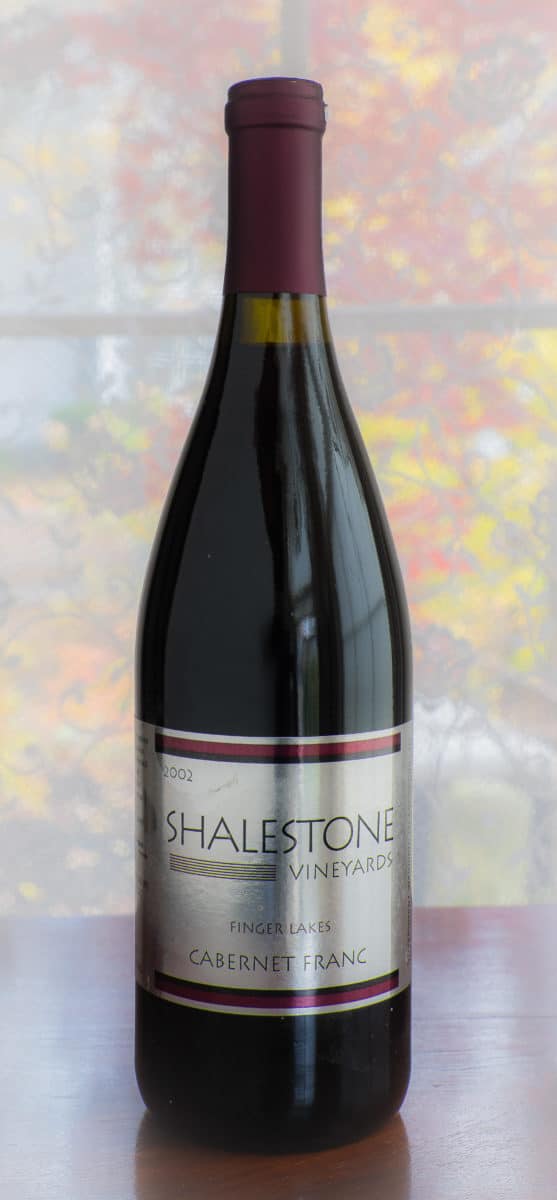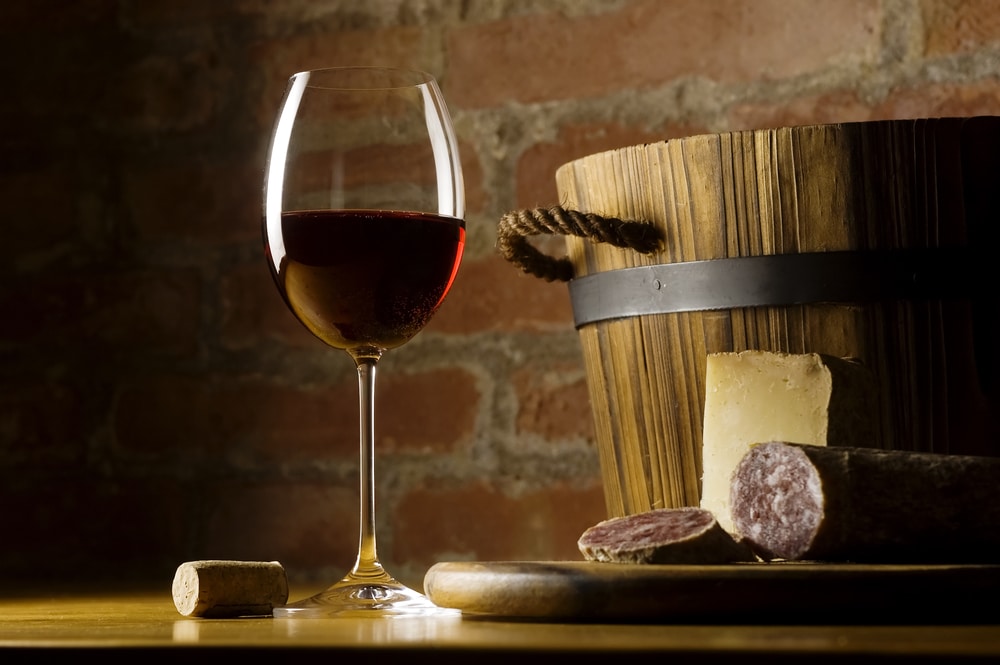What’s known as “King Cab” is, as one might expect, Cabernet Sauvignon. Yet until 1979, Cabernet Franc was more widely planted in France than was Cabernet Sauvignon. Indeed, as Oz Clarke writes, “Cabernet Sauvignon is [Cabernet] Franc’s offspring.”*
But by the time Jancis Robinson published her seminal Vines, Grapes and Wines, 1986, she would have reason to write, “Cabernet Franc languishes in the shadow of the much more revered Cabernet Sauvignon,” and is regarded as its “ignoble form.”

She considered this unfair. She wrote that Cabernet Franc was able to produce “truly great wines” in France. She made virtually no mention then of Cabernet Franc wines in the United States.
Thirty years later, however, she wrote of North American Cabernet Franc being blended (with its more noble form, into what is essentially a Bordeaux fusion) in California and being produced by itself in Washington state but “really coming into its own in the north east…particularly successfully…in the Finger Lakes.”
Oh, the Finger Lakes. If it weren’t for the fact that I had recently moved to a new home about 400 miles from there and would have had to take the votes of others in my family, I might have moved there within a few minutes of having arrived there for the first time.
Or perhaps it wasn’t a mere few minutes. Perhaps I’d had to try a few Finger Lakes wines first.
Except it wasn’t really those wines, which — despite the fact that now, some 20 years later, they are not all that easy to find — can, like most wines, be found elsewhere.
It was the particular beauty of the place. And I’m not one to fall in love with mere beauty (though seduction is another matter).
The Finger Lakes region, which as an AVA (American Vitaculture Area) encompasses over 10,000 acres of vineyards, is so named because its very narrow lakes, which run north/south, resemble fingers. There are more than five (eleven, in fact), but the central five on a map resemble thin digits coming out from a palm. Seen on maps (and, presumably, from way above), they beckon one to come within their grasp.
There have been some who believe that those five lakes came into being when God (“Great Spirit”) pressed a hand (perhaps a bit too rapturously) upon the land in a blessing of those lakes upon their creation.
But their real beauty is to be seen on the ground, the way they seem carved deep in the land that rises at a sharp V angle on either side of the lakes, which glisten wateringly and glow in the light of day, silver fingers against (except in winter) the great green slopes that drop precipitously down to their shores.
I don’t know if others do what I do: upon learning that glaciers formed lakes I see, I imagine myself standing at a safe distance watching those same glaciers move upon the land and scrape across it and carve into it deep incisions that then fill with water in which is reflected the sky into which these same glaciers eventually ascend. I accomplish in a few minutes what it takes nature thousands of years to accomplish. Such is the power of unrestrained, often foolish but fulfilling human imagination.
Seneca Lake is the Finger Lakes’ second longest, after Cayuga Lake, but it is the largest in terms of its volume of water, because it’s the deepest. So deep is Seneca Lake (188 meters/618 feet) that it was used by the U.S. Navy during World War II for submarine training, an inland ocean-depth body of water safe from ocean-based enemy attack. To this day, there is on Seneca Lake a Navy sonar test facility, The Naval Undersea Warfare Center.
But today the Seneca Lake’s mantra might be — if we may quote a bumper sticker — “Make Wine, Not War.”
Winemaking was established on Seneca Lake immediately after the American Civil War. But the region wasn’t established as an AVA until 1988. Today there are more than 30 wineries on its shores.
The Finger Lakes have become increasingly renowned for their white wines, particularly Rieslings. The generally cool climate favors white grapes. But a number of wineries make red wines, in particular from those most suited to cooler climates: Pinot Noir, Lemberger (aka Blaufrankisch), and Cabernet Franc, which a United States Department of Agriculture/National Institute of Food and Agriculture-sponsored website says is “the most suitable red vinifera variety in very cool climates,” which accounts for its presence and success in the Loire Valley, one of Frances’s most northern grape-growing areas.
But there is only one Finger Lakes winery that, daringly, makes only red wines. And has done the same since its founding in 1998. Its own mantra then, as it remains, is: Red is All We Do.
And so was it printed on the perfect, high-quality cork I removed from the winery’s 2002 Cabernet Franc:
Shalestone Vineyards. Red Is All We Do.
Poured into a large, red-wine (Syrah) glass, the wine immediately showed its age (15+ years, unusual for a Finger Lakes red and for many Cabernet Franc expressions from anywhere in the wine world). It was as much golden as red but not golden the way an old dry white wine would be, cloudy with unfiltered sunlight. This was golden with a tincture of blood, squirms of original color swimming through its own age-depleted hue.
Sometimes the leaching of coloration proclaims a dead or dying wine. But it was immediately apparent from the clean, yet smoky, bright, powerful fragrance of this wine that it was vastly, almost pugnaciously (as it punched one’s nose) alive.
It was equally aggressive on the palate — tart, pleasantly biting (but not stinging), dancing over the tongue and between the teeth (when being oxygenated with the intake of breath and then, to some people annoying, shlupping sound of wine being coaxed out of its raiment).
The Cabernet Franc was served that evening with Bourbon-Marinated Roast Pork (aka “Not for the Common People”), one of the three wines I’d suggested as pairings for that recipe in Dinner for Eight: 40 Great Dinner Party Menus for Friends and Family (2005). (The other two were Gewürztraminer and Riesling Spätlese, to give some idea of the slot into which one might attempt to slip a Cabernet Franc.)
That dish is accompanied by a white sauce whose predominant sense (which is more than flavor) comes from very hot dry mustard. The Cabernet Franc didn’t bend, let alone break.
What did break during that meal was another Cabernet Franc: 2005 Chinon Les Mureaux by Jean Dumont. Lesson learned. (In this case, not every Cabernet Franc is going to work with that dish.)
The next day it was drunk at lunch with leftover Chinese food (our usual bash and mash of pork, chicken, beef, tofu — separate dishes, I mean, all Szechuan but not all extra spicy). There was no diminishment of power in the wine, though there was a slight increase in elegance. It’s not that there were tannins to burn off — there were none apparent — but that the wine clearly needed a bit of time (oxygen) to continue to open up. This is a good sign for its ability to age further (if one happens to have the 2002 Shalestone lying around; I wish I did).
Days 3-6. Little tastes of the wine with the remains of the afore-consumed pork and other food too varied or unimpressive to mention. It was as if I was challenging a wine that looked half-dead a week before to give up and die before I did.
On the 7th day there was no further fading of the color. In fact, there was a kind of contradictory intensification of the red. If the wine had been an old person going into the gym, it was walking out of the gym looking at the very least as if it had been in the tanning booth after a long ride on an elliptical.
There was also, this late in the game, only the slightest hint of oxidation, which is remarkable for a Finger Lakes red from a grape not known for its power over time-since-uncorking.
On its final day, the wine was finished up with some steak au poivre (cooked in an Armagnac 25 ans, which, for those with label envy, actually means very little). It must have amazing acidity, because it was now (nearly) as fresh as when it had been opened over a week (9 days, actually) before.
It said goodbye by depositing a beautiful slab of sediment across the bottom and up the sides of my large wine glass. I was tempted to save it (the sediment) and lick at it over the next couple of days. I didn’t (no saving, so no licking). But at least I have the glorious memory, hereby passed along, of the unexpectedly glorious wine it graced with its presence and its farewell. ![]()
